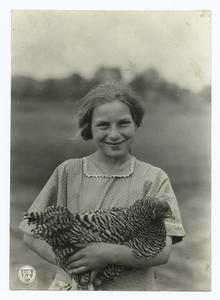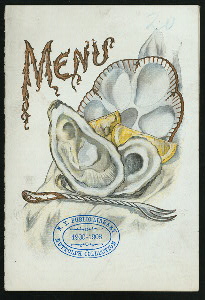
Name: Kim Beeman
Occupation: Librarian (and student) at the French Culinary Institute in New York.
Desert Island Cookbook: Bull Cook and Authentic Historical Recipes and Practices by George Leonard Herter.

Why Bull Cook? Kim explains:
I bought a copy of Bull Cook and authentic historical recipes four years ago, after seeing it described as a "bombastic comic-culinary masterpiece." With recipes for "Spinach Mother of Christ," "Olives Forum of the Twelve Ceasers," Hors d'Oeuvres Turkistan," and the ever-popular "How to Make Shallots from Onions," it did not disappoint.
George Leonard Herter, sportsman and amateur historian, self-published Bull Cook in 1960. Proprietor of Herter's, a sporting goods store in Waseca, Minnesota, ("Tenacious for Quality since 1893"), his cooking credentials remain obscure. In the first paragraphs of the book, he set out his intentions.
For your convenience, I will start with meat, fish, eggs, soups and sauces, sandwiches, vegetables, the art of French frying, desserts, how to dress game, how to properly sharpen a knife, how to make wines and beer, how to make French soap, what to do in case of hydrogen or cobalt bomb attack. Keeping as much in alphabetical order as possible.Of all the cookbooks, I have ever come across, I think that this is the only one that deals with cobalt bomb attacks.
Herter, confident and enthusiastic, filled his book with dubious historical and culinary claims. The Italians don't know how to make a tomato sauce! The Virgin Mary loved both spinach and bagpipes! Genghis Khan liked his ducks cooked in rhubarb and honey! Escoffier had a fondness for canned kidney beans! The recipes that accompany these stories are mostly unremarkable, if suspiciously American-sounding (onion powder and cream of mushroom soup make frequent appearances).
I love this cookbook, not because I trust Herter or his recipes, but because I love the way he forges ahead, unfettered by footnotes or references, and tells the story of food as he sees it. Lucky for me, this book was such a success that he followed it up with two more volumes, each more exciting than the last. A singular contribution to the world of cookbooks, to say the least!
Hors D'Oeuvres Turkistan
(taken from Bull Cook and authentic historical recipes and practices)
The prune, although often thought to be of European origin, originated in western Asia in the area south of the Caucasus Mountains to the Caspian Sea. Prunes came to Europe fairly recently by being introduced into Hungary from Turkistan late in the 15th century. They were introduced as a before-the-meal appetizer and were at first so expensive that you could actually buy good quality Turkish harem girls by the pound much cheaper than you could prunes. The rage of Europe became Hors d'Oeuvres Turkistan.
Here is the original recipe and I must say that it is a welcome change from the junk that you see on most hors d'oeuvre trays today.
Buy a package of good quality prunes. Boil them in water until barely done, according to the instructions on the package. Drain the prunes and place them on a plate. Take a sharp, pointed knife and make a slit lengthwise across the top of the prunes and remove the pit. Take a 3 oz. package of soft white cheese. Philadelphia cream cheese is excellent for the purpose. Place the cheese in a bowl. Add two level tablespoons of honey or sugar. Three level tablespoons of chopped walnuts and one-eighth teaspoon of anise liquid flavoring. Now with a fork mix everything together to form a smooth paste. Take the paste and stuff the prunes with it. Place the prunes on a plate and serve. They make fabulous eating.
Herter's other works are also worth reading, including Professional guide's manual (1960) which contains nuggets of philosophical wisdom ("You cannot stay lost in the woods unless you want to)" and provides crucial information about the outdoor life such as "Using beer cans to help attract ducks and geese into picked corn fields," and "How to make a moose call from bark or tar paper."


Another Herter classic is the Truth about hunting in today's Africa and how to go on safari for $690.00. Beyond its striking cover (see below), one can also learn how best to shoot a lion.


His other titles include Herter's professional course in science of modern taxidermy, European and American professional sourdough cooking and recipes, and perhaps his pièce de résistance: How to make the finest wines at home in old glass or plastic bottles and jugs for for as little as 10 [cents] a gallon!
So I'm going to raise a glass of (homemade) wine to Kim for bringing George Herter into my life!










![DAILY MENU [held by] RESTAURAN... Digital ID: 468796. New York Public Library DAILY MENU [held by] RESTAURAN... Digital ID: 468796. New York Public Library](http://images.nypl.org/?id=468796&t=r)



![Provincetown [Massachusetts], ... Digital ID: 55092. New York Public Library Provincetown [Massachusetts], ... Digital ID: 55092. New York Public Library](http://images.nypl.org/index.php?id=55092&t=r)

